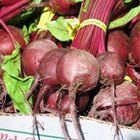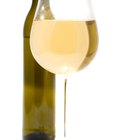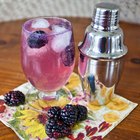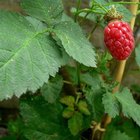
Wine making is a process of harvesting, crushing and pressing, fermentation, clarification, aging and bottling. Wine, in the traditional sense, is made with grapes and little else, as grapes naturally contain the sugars, acids, esters and tannins necessary to create a stable wine. Nearly any fruit - with a few additions - can be made into wine. Sand plums that grow wild in the southern U.S. are popular in homemade wines, and recipes vary widely. Japanese plum wine and Texas plum wine, for example, are very different products, but the process is similar.
How to Make Sand Plum Wine
Bring the water and sugar to a boil.
Wash the plums. Remove the stems and pits, and discard any plums that are damaged or beginning to rot. Cut the plums clean plums into small pieces, saving the juices.
Put the plums into a straining bag and place in the bottom of the primary fermenter. Mash the plums with a sterile piece of wood - a baseball bat works well.
Pour the boiling sugar and water over the plums to the 1-gallon mark.
When cooled, add the tannin, yeast nutrient and Campden tablet. Fit it with an air lock.
Wait 12 hours, then add the pectic enzyme.
Wait an additional 24 hours, then add the Champagne yeast and stir.
Remove the straining bag after one week.
When the mixture reaches specific gravity of 1.030, rack to a secondary fermenter. Rack the mixture again in two to three weeks, and again after two to six months.
When fermentation is complete, add Campden tablets to stabilize the wine and add sugar to taste.
Bottle the wine and allow it to age for at least six months. Winemakers recommend aging for at least two years.
Related Articles

How to Make Chokecherry Wine

How to Make Wine in a Gallon Jug

How to Make Merlot Wine

How to Use Bentonite for Clearing Wine

How to Make Pickle-Infused Vodka

How to Make Red Beet Wine

Make It a Manhattan: Classic Manhattan ...

How to Make Cranberry Wine

How to Make Hard Cider With Baking Yeast

How to Mix Liquor With Fresh Fruit & ...

How to Use Wine Conditioner

How to Reduce Wine With Sugar to a Glaze

How to Make Apples Into Wine in 21 Days

How to Make Blackberry Brandy

Tayberry Jam Recipe

How to Eat Raspberries

Does Yeast Turn Juice to Alcohol?

Lemon Juice Substitutes in Apple Pie

How to Strain Seeds From Fruit When ...

How to Make Alcohol at Home
References
Writer Bio
Emily Jarvis is a graduate of University of Georgia Grady College of Journalism. Her articles have appeared in "Southern Distinction Magazine" and "The Red & Black." Jarvis holds a Bachelor of Arts in magazine journalism and a Master of Arts in journalism.
Photo Credits
Ablestock.com/AbleStock.com/Getty Images